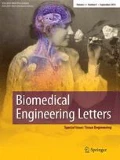Abstract
Additive manufacturing (AM) is an alternative metal fabrication technology. The outstanding advantage of AM (3D-printing, direct manufacturing), is the ability to form shapes that cannot be formed with any other traditional technology. 3D-printing began as a new method of prototyping in plastics. Nowadays, AM in metals allows to realize not only net-shape geometry, but also high fatigue strength and corrosion resistant parts. This success of AM in metals enables new applications of the technology in important fields, such as production of medical implants. The 3D-printing of medical implants is an extremely rapidly developing application. The success of this development lies in the fact that patient-specific implants can promote patient recovery, as often it is the only alternative to amputation. The production of AM implants provides a relatively fast and effective solution for complex surgical cases. However, there are still numerous challenging open issues in medical 3D-printing. The goal of the current research review is to explain the whole technological and design chain of bio-medical bone implant production from the computed tomography that is performed by the surgeon, to conversion to a computer aided drawing file, to production of implants, including the necessary post-processing procedures and certification. The current work presents examples that were produced by joint work of Polygon Medical Engineering, Russia and by TechMed, the AM Center of Israel Institute of Metals. Polygon provided 3D-planning and 3D-modelling specifically for the implants production. TechMed were in charge of the optimization of models and they manufactured the implants by Electron-Beam Melting (EBM®), using an Arcam EBM® A2X machine.






Courtesy of J. Ramon and G. Muller, TechMed Technion


Courtesy of G. Dzhenzhera and E. Strokin


Similar content being viewed by others
References
Official web-site of Arcam EBM® AB, machines manufacturer. http://www.arcam.com. Accessed July 2018.
Kamsky GV, Kolomiets AA, Popov VV. Review of the main producers of 3D-machines for metals, characteristics of the machines, and directions of development. Res J Int Stud. 2016;8(50): ISSN 2227-6017.
ASTM WK30522: New specification for additive manufacturing Titanium–6 Aluminum–4Vanadium with powder bed process. http://www.astm.org/DATABASE.CART/WORKITEMS/WK30522.htm. Accessed 2018.
Woo DG, Kim CH, Kim HS, Lim D. An experimental–numerical methodology for a rapid prototyped application combined with finite element models in vertebral trabecular bone. Exp Mech. 2008;48:657.
Woo DG, Kim CH, Lim D, Kim HS. Experimental and simulated studies on the plastic mechanical characteristics of osteoporotic vertebral trabecular bone. Curr Appl Phys. 2010;10(3): 729–733, ISSN 1567-1739. https://doi.org/10.1016/j.cap.2009.07.021.
Official web-site of Materialise, Medical R&D Software packages. http://www.materialise.com/BiomedicalRnD. Accessed 2018.
Koptyug A, Rännar L, Bäckström M, Fager Franzén S, Dérand P. Additive manufacturing technology applications targeting practical surgery. Int J Life Sci Med Res. 2013;3(1):15–24.
Popov V, Katz-Demyanetz A, Garkun A, Muller G, Strokin E, Rosenson H. Effect of hot isostatic pressure treatment on the electron-beam melted Ti–6Al–4V specimens. Procedia Manuf. 2018;21:125–132, ISSN 2351-9789. https://doi.org/10.1016/j.promfg.2018.02.102.
Popov V, et al. Heat transfer and phase formation through EBM 3D-printing of Ti–6Al–4V cylindrical parts. Defect Diffus Forum. 2018;383:190–5.
Chudinova E, Surmeneva M, Koptyug A, Scoglund P, Surmenev R. Additive manufactured Ti–6Al–4V scaffolds with the RF–magnetron sputter deposited hydroxyapatite coating. J Phys Conf Ser. 2016;669:012004. https://doi.org/10.1088/1742-6596/669/1/012004.
ASTM additive manufacturing technology standards. https://www.astm.org/Standards/additive-manufacturing-technology-standards.html. Accessed 2018.
Sáenz de Viteri V, Fuentes E. Titanium and titanium alloys as biomaterials, tribology—fundamentals and advancements. In: Dr. Jürgen G, editor. InTech. 2013. https://doi.org/10.5772/55860.
Cronskär M, Rännar L-E, Bäckström M, Nilsson KG, Samuelsson B. Patient-specific clavicle reconstruction using digital design and additive manufacturing. J Mech Des. 1990;137(11):2015.
Koptyug A, Rännar L, Bäckström M, Cronskär M. Additive manufacturing for medical and biomedical applications: Advances and challenges. Mater Sci Forum. 2014; pp. 1286–1291.
Heinl P, Müller L, Körner C, Singer RF, Müller FA. Cellular Ti–6Al–4V structures with interconnected macro porosity for bone implants fabricated by selective electron beam melting. Acta Biomater. 2008;4(5):1536–44.
Official web-site of Polygon Medical Engineering. Russia. www.polygonmed.ru. Accessed 2018.
Korytkin AA, Zakharova DV, Novikova Ya S, Gorbatov RO, Kovaldov KA, El Moudni YM. Custom Triflange Acetabular Components in Revision Hip Replacement (Experience Review). Travmatologiya i ortopediya Rossii [Traumatology and orthopedics of Russia]. 2017:23(4); pp. 101–111 (in Russian). https://doi.org/10.21823/2311-2905-2017-23-4-101-111.
Berasi CC, Berend KR, Adams JB, Ruh EL, Lombardi AV. Are custom triflange acetabular components effective for reconstruction of catastrophic bone loss? Clin Orthop Relat Res. 2014;473(2):528–35. https://doi.org/10.1007/s11999-014-3969-z.
Li H, Qu X, Mao Y, et al. Clin Orthop Relat Res. 2016;474:731. https://doi.org/10.1007/s11999-015-4587-0.
Nakano T, Fujitani W, Ishimoto T, Lee J, Ikeo N, Fukuda H, Kuramoto K. Formation of new bone with preferentially oriented biological apatite crystals using novel cylindrical implant containing anisotropic open pores fabricated by electron beam melting (EBM) method. Tetsu-to-Hagane. 2010;96:572–8.
Acknowledgements
This research did not receive any specific funding from the public, commercial, or not-for-profit sectors. You may contact the corresponding authors for any additional information and for the original results.
Author information
Authors and Affiliations
Corresponding author
Ethics declarations
Conflict of interest
The authors declare that they have no conflict of interest.
Ethical approval
Ethical approval was obtained in Russia according to the local guidelines.
Rights and permissions
About this article
Cite this article
Popov, V.V., Muller-Kamskii, G., Kovalevsky, A. et al. Design and 3D-printing of titanium bone implants: brief review of approach and clinical cases. Biomed. Eng. Lett. 8, 337–344 (2018). https://doi.org/10.1007/s13534-018-0080-5
Received:
Revised:
Accepted:
Published:
Issue Date:
DOI: https://doi.org/10.1007/s13534-018-0080-5




